Back when I first started gardening, I thought leaving a pumpkin vine to grow every which way was the only way to keep it alive and well.
Turns out, this isn’t necessarily true.
While it’s not absolutely necessary to trim the vines, doing so can encourage a more abundant harvest, and larger pumpkins.
The main reasons why gardeners trim their pumpkin plants are to prevent them from choking out other plants in the garden, for ease of maintenance, and to increase airflow between the leaves, which can help to prevent disease.
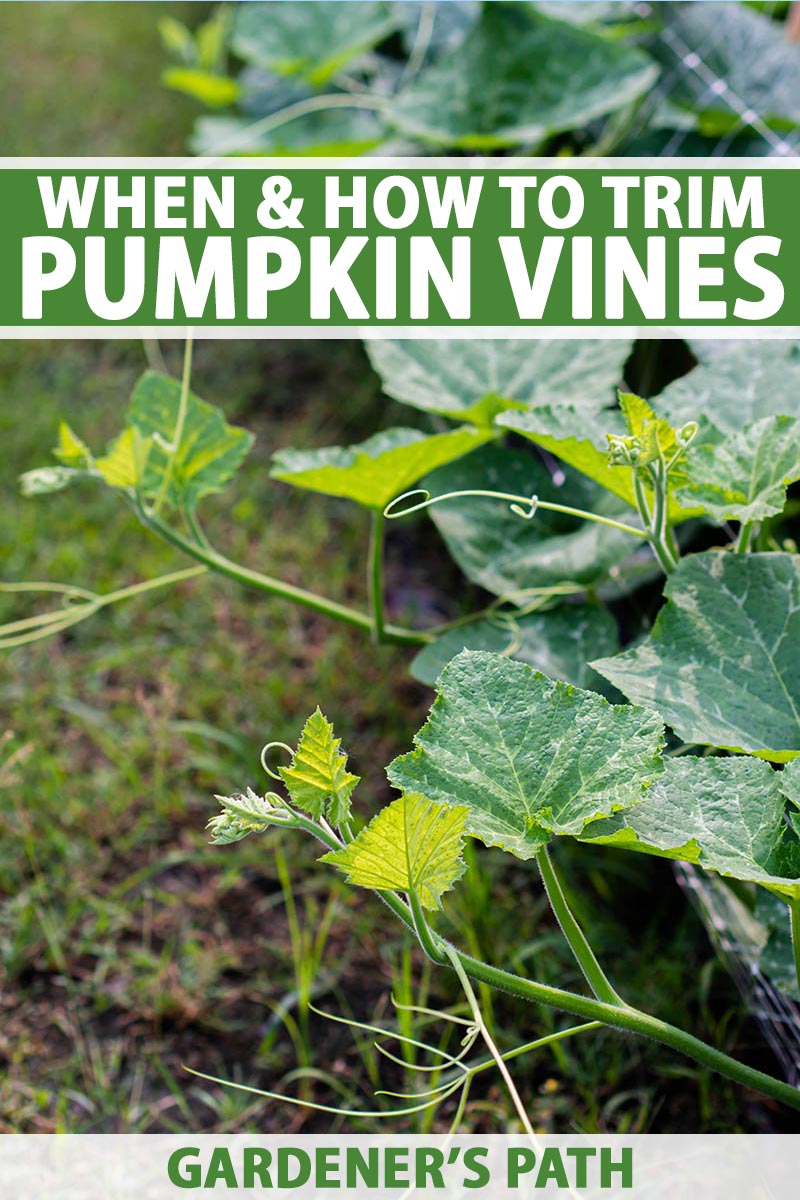
We link to vendors to help you find relevant products. If you buy from one of our links, we may earn a commission.
Additionally, by sacrificing some of the younger fruit, it allows the plant to put all its energy into developing the remaining pumpkins.
If you’re growing pumpkins – which you can learn more about in our growing guide – you’ll need to know how to manage them.
Here’s what you’ll discover:
What You’ll Learn
Anatomy of a Vine
Before we get into the nitty-gritty of when and how to trim your pumpkin plant, here are a few things to know about their growth habits.
First, there’s the main vine, which is the one directly attached to the roots that grows out of the ground. It’s the thickest one you’ll see when you inspect your plant.

Growing from the main vine are secondary vine called “runners,” which produce secondary roots if left to grow uninterrupted.
You can also encourage growth of secondary roots by burying the stem, as you’ll see below. These runners can, in turn, produce additional runners known as tertiaries.
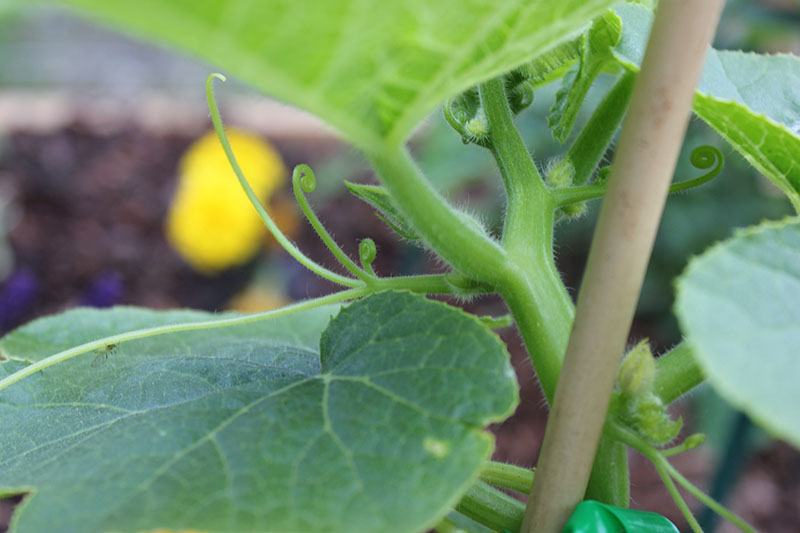
Leaves and blooms – and therefore fruits – can grow from any of these vines. However, it is best to remove any tertiary runners as soon as you notice them, to avoid diverting nutrients from the main and secondary vines.
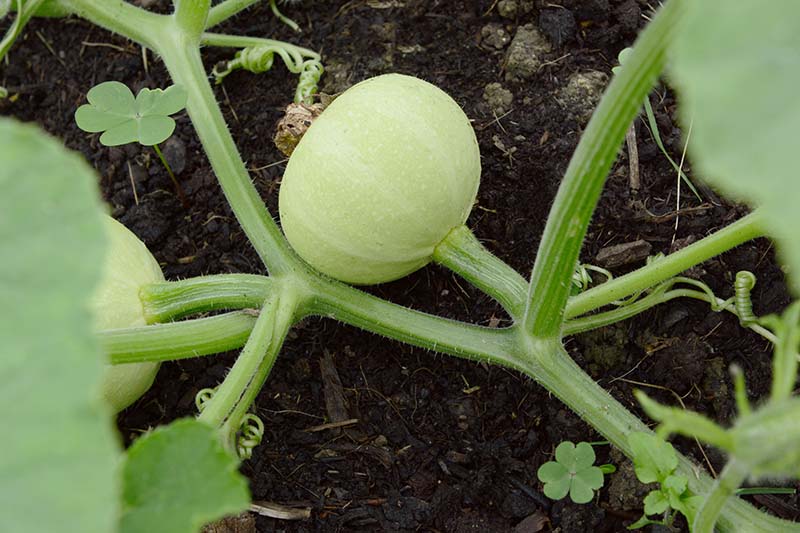
It can be confusing to sort out which is which, but it’s worth taking the time to familiarize yourself with your plant so that when the time comes to trim, you’ll know what you’re looking at.
When to Prune
Before you do any trimming, wait until they are at least 10-15 feet long. Ideally, you should try to hold off until you’ve got two to five established fruits growing for larger varieties, or about 10-12 little gourds on smaller cultivars.
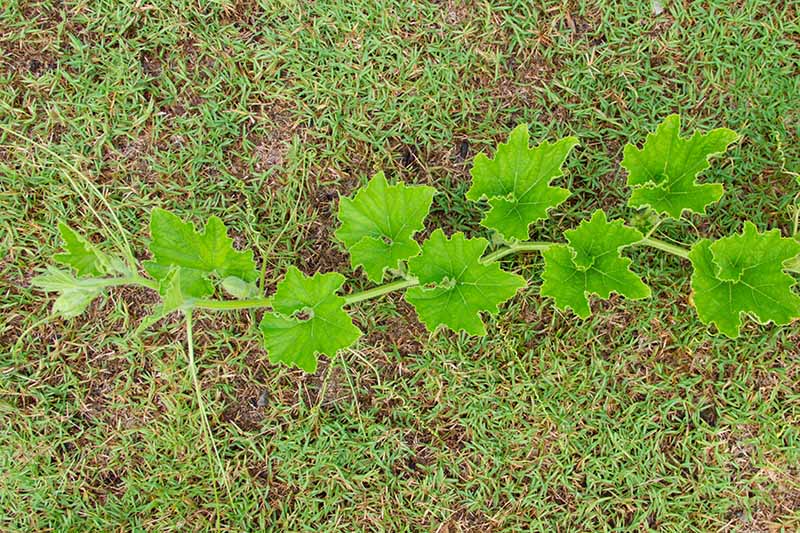
Earlier this year when I was growing tomatoes, I noticed a leaf spot starting to develop on the lower leaves of the plant.
Panicking, I researched what I should do to keep the plant healthy. It turned out it was a fungal infection, and happily, the answer was easy: trim away affected leaves and prune the lower portion of the plant to remove the leaves.
That way, water splashing up from infected soil won’t cause the fungus to reinfect new lower leaves.
It worked, and my tomatoes are thriving. But my young pumpkin leaves soon developed a few small whitish spots on the edges, and I panicked yet again.
This time, without doing any additional research first, I trimmed a few leaves back when the stem was barely a foot long.

I’m not sure what the spots were, and the plants seem fine now. But they’re growing more slowly than they probably would have if I hadn’t recklessly removed the leaves, disrupting their early growth.
Here are a few additional guidelines for when to trim:
- Trim the main vine when it is 10-15 feet long when measured from the center of the plant.
- Prune the tips of the secondary runners when they are about 8-10 feet long.
- Tertiary vines (those that grow off the runners) should be trimmed as soon as you see them appear.
It’s really that easy.
Now, let’s talk about how to trim your pumpkin plants.
How to Trim
Equipment-wise, all you’ll need for pruning is a pair of gardening gloves, some pruning shears, and a tape measure.
To trim the main vine, measure 10-15 feet from the center of the plant where it grows out of the ground. If there’s an established fruit growing at that point and you want to keep it, don’t cut yet!

Instead, measure another five or so feet past the last healthy fruit and make your cut there.
However, if the fruit is soft or it’s the sixth or seventh gourd on the plant, including those growing on the secondary runners, cutting it off can help your plant focus its energy on the other five squashes.
This means bigger, tastier, prettier pumpkins for you.
To prune secondary runners, measure about 10 feet from where the runner shoots off the main stem and trim it there.
Because they divert nutrients and energy from the main and secondary vines, it’s a good idea to trim tertiaries as soon as you see them.

After you make a cut, bury the severed tip an inch or two deep in the soil and cover it with mulch.
This will help to prevent the plant from drying out, and it’ll also make it harder for pests to invade or disease to take hold.
Plus, if you keep the soil moist, it should develop a secondary root system where it was cut, resulting in more nutrition for your growing gourds.
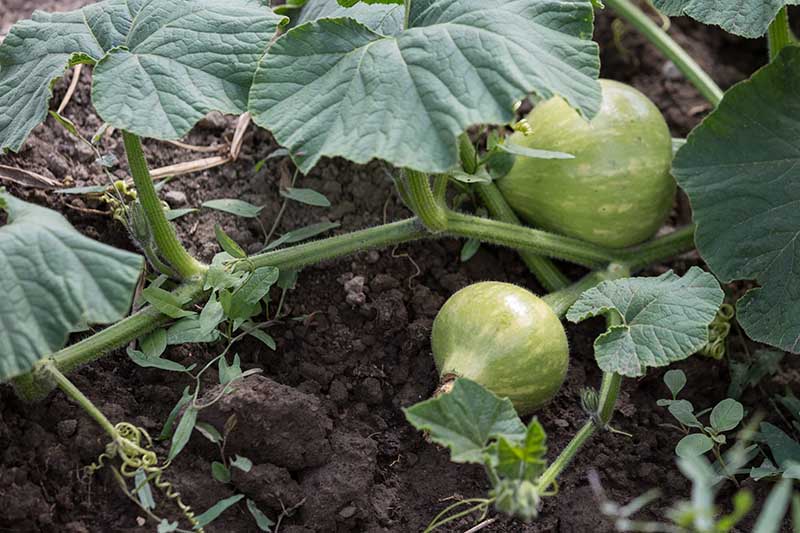
By keeping the plant trimmed and neat, you’ll encourage it to grow strong, healthy squash. And isn’t that the ultimate goal of any pumpkin grower?
No Rat’s Nest Here
You don’t have to prune your pumpkin plants. You’ll still get some fruits, even if you let them run wild.
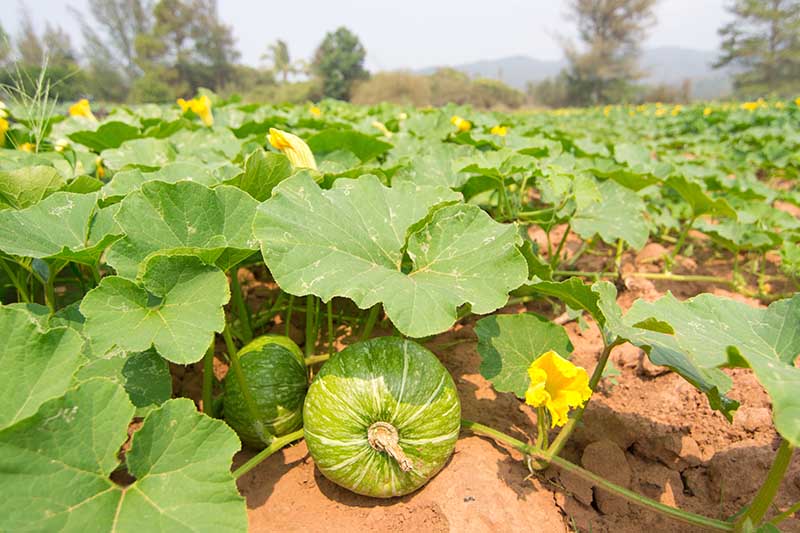
But it’ll be like letting a toddler’s curly mop of hair grow and grow without brushing or trimming it to keep it healthy.
(Am I speaking from personal experience? Maybe. Just maybe…)
A pruned pumpkin patch is a happy one, so don’t be afraid to pull out those pruning shears and get to work.
Have you ever trimmed your pumpkin plants? Let us know in the comments below!
And for more information about growing pumpkins in your vegetable garden, check out these guides next:
- 5 Reasons Your Pumpkin Vine Isn’t Blooming
- How and When to Fertilize Your Pumpkin Plants
- Best Companion Plants to Grow with Pumpkins
- 5 Reasons Why Your Pumpkin Isn’t Producing Fruit
Photos by Laura Melchor © Ask the Experts, LLC. ALL RIGHTS RESERVED. See our TOS for more details. Uncredited photos: Shutterstock.
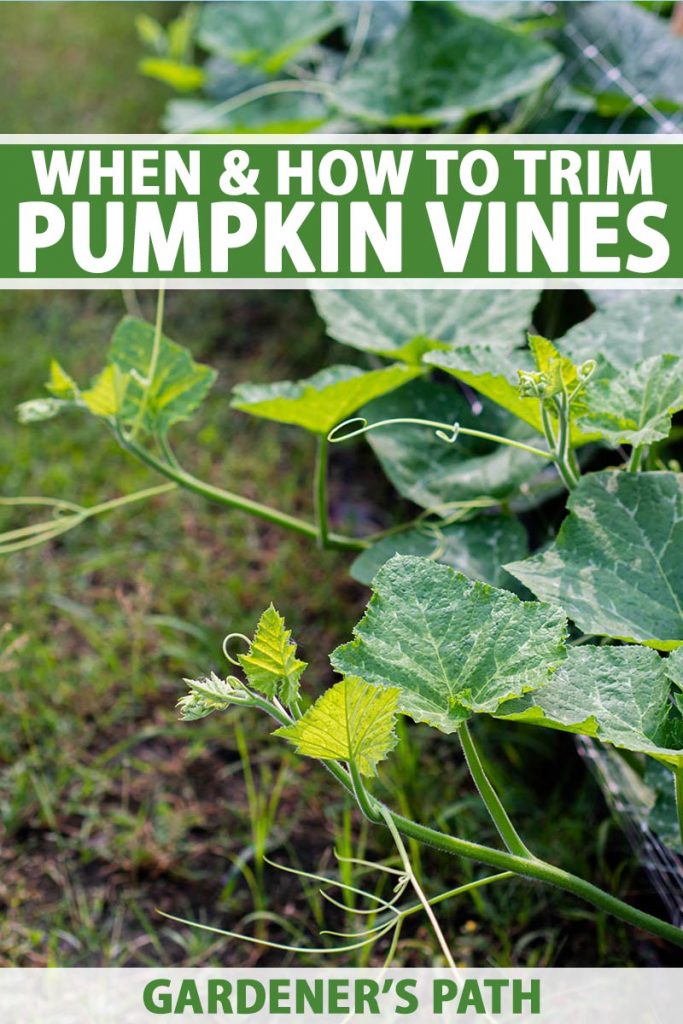


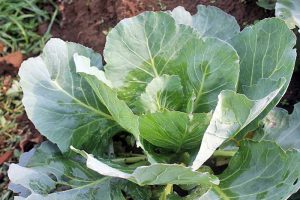
Laura, My pumpkin had a number of leaves that look liked a variegated leaf. They were not yellow just had streaks. I looked today and the varigation has faded. Have you seen this?
Hi John, thanks so much for reading. I haven’t seen variegation like that on a pumpkin, but some gardening friends have. Usually it’s just a case of natural variations in pigmentation of the leaf. As in your case, the variegation disappeared and the pumpkins went on to grow healthy gourds. Was the variegation on your plant white? If so, your pumpkins are probably fine. Though my pumpkins haven’t had this, my pea leaves this year are all variegated with white. (The variety I planted last year did not have this variegation, so it worried me until I researched it… Read more »
I have only one pumpkin on my vine. It had turned orange already. Should I cut the vine for more pumpkins?
Hi Tracey! Is your vine still producing flowers? That’s probably the best way to know whether you can get more pumpkins out of the plant. I’d trim any tertiary vines you see, as those can take away from flower and fruit production, and then add phosphorus to get some blooms going. Check out our guides to pumpkin fertilization and pollination for in-depth tips!
My pumpkin patch has gone wild and I am going to get out there and start pruning. In the center of the patch there is an area of healthy yellow leaves.
I tried to find potassium fertilizer that could be sprayed on. What do you use for a potassium fertilizer?
Hi Jan! For a potassium (and phosphorus) boost, I like to use this foliar spray from Amazon. It also contains micronutrients that help your plants stay happy and healthy, but the two main macronutrients are potassium and phosphorus — and your pumpkin needs both.
Can I prune my vines before flowering???
Hi Juuko! It’s best to wait until the vines are at least 10-15 feet long and there are at least two to five established fruits for larger varieties and 10-12 fruits for smaller ones. The plant needs all the energy it can get in order to flower, so you don’t want to remove vines too early. I hope this helps!
A good remedy for powdery mildew in your gourds is a copper based fungicide or 1-2 tablespoons apple cider or white vinegar to a gallon of water sprayed liberally on foliage. Be very careful when trimming affected leaves and make sure to clean shears with bleach, vinegar or alcohol to prevent spread of spores! Hope that helps 🙂
I have powdery mildew and everything I have read said to trim affected leaves which is a lot of them. I really hope my pumpkins survive til October without many leaves.????
Hi Re how pumpkins grow, do they grow from the base of the plant or from the ground where the vines put down little roots?
The plant grows both ways — mainly from the primary root system, but also from buried vines that put down roots. The fruit itself grows from pollinated female flowers. You can read more about pollination in our guide to hand pollinating pumpkins. I hope this helps!
I am trellising pumpkins this year. Should I wait until they are on the other side of the trellis so I can plant the tips in soil? Or can I tie a bag of dirt to the cut end?
Hi Gidget! Thanks for your question. You could probably let a few of the vines go up the trellis and direct a few toward the soil to bury the tips. Or, you could do what you said and wait until they are on the other side of the trellis.
I know nothing about gardening! But I need help with a volunteer plant that may be out of control! Help I’m excited and want to take care of it without killing it!
Hi Rachel! I’d love to help. What are the details regarding this plant? Any photos?
I’m not sure but was told this is a pumpkin. It just came up.
Hi Julie! I’d love to help. Do you have any photos you can attach?
I viewed your blog last year when I started growing pumpkins for the first time. I was extremely confused. I went back and read it a few more times and I was still confused. I had four pumpkin plants and by the end of the season I had one very undeveloped pumpkin. This year I started my pumpkin seeds a lot earlier and I went back to your blog. Let’s just say last year’s confusion has a lot to do with my lack of experience and my own comprehension skills, ha! It was my first time ever growing anything so… Read more »
Hi Jordyn! I’m so happy to hear that your pumpkins are thriving this year. What wonderful news! I’m glad this article helped you. There’s nothing like that rush of success when it comes to gardening, is there? Your harvest is going to be so much fun this year!